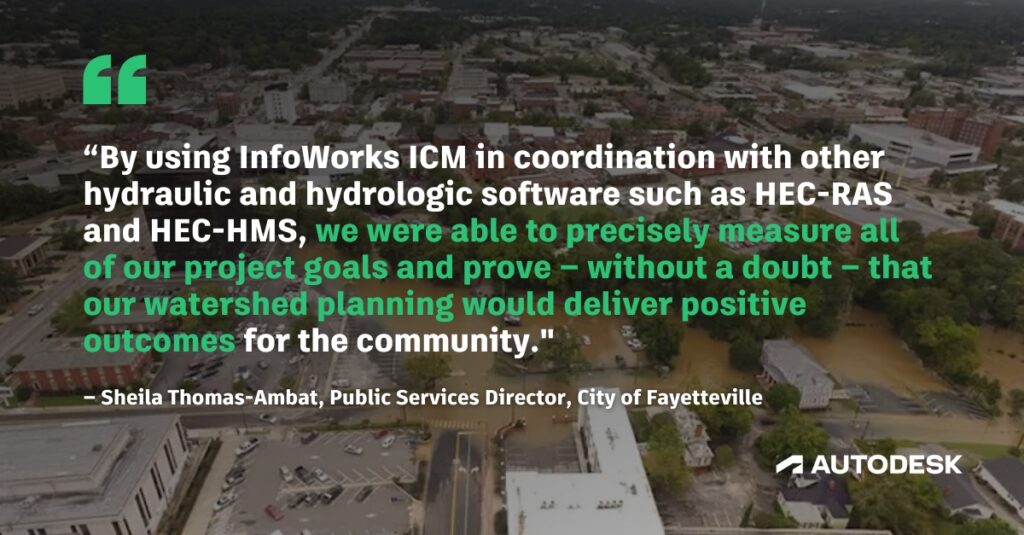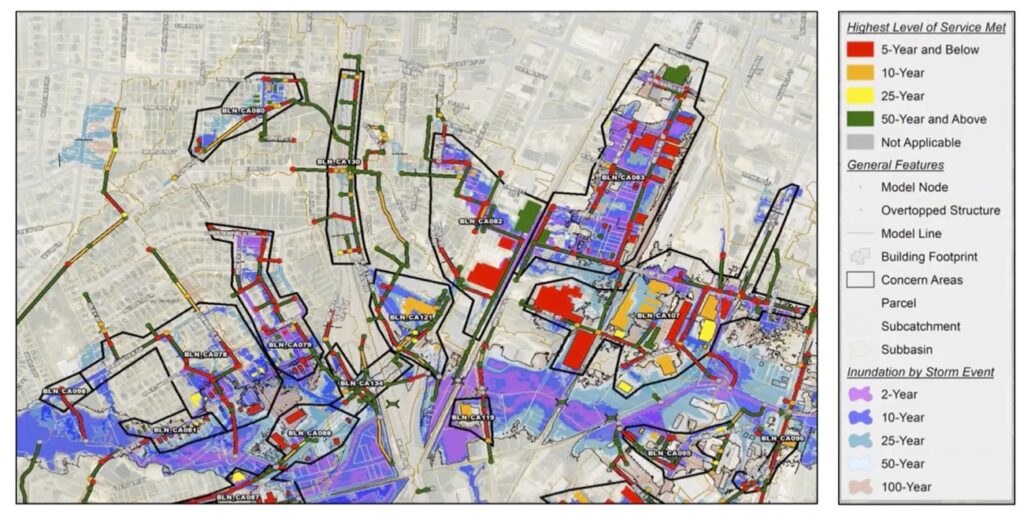& Construction

Integrated BIM tools, including Revit, AutoCAD, and Civil 3D
& Manufacturing

Professional CAD/CAM tools built on Inventor and AutoCAD
7 min read
By the year 2100, the EPA estimates that global precipitation could rise as much as 30%, with the frequency and intensity of storms rising significantly as well. Combatting flooding events and storm surges is top of mind for most in the stormwater industry. With these growing challenges comes the growing need for digital tools and modeling programs that can effectively forecast, predict, and model these weather events to help us plan, design, and build water infrastructure. While we at Autodesk have built a growing suite of hydraulic and hydrologic modeling software tools, we also recognize the great work that the U.S. Hydraulic Engineering Center has done developing tools like HEC-RAS and HEC-HMS.
In this post, we’re going to walk through some of the benefits and differences between InfoWorks ICM and HEC software, and also present a combined modeling workflow that Arcadis leveraged in stormwater modeling for the City of Fayetteville.
InfoWorks ICM and HEC-RAS are two of the most common 2D hydraulic modeling solutions available on the market. While HEC-RAS is a free tool developed by the U.S. government, InfoWorks ICM is Autodesk’s privately developed integrated catchment modeling solution developed through years of expertise in the industry. Both tools are great, and it’s important to note, in talking with many InfoWorks ICM users, it’s clear that a number also run parallel models in HEC-RAS and HEC-HMS. So, how do you know which one to choose, what the differences are, and when to use both? Let’s dig in.
To start, if you’re simply wondering which solution to use for 2D hydraulic modeling, the short answer is that InfoWorks ICM has superior modeling capabilities, impressive collaboration workflows with the Workgroup Database, and with access to cloud simulations and free training and support. When it comes to selecting your stormwater modeling system of choice, our recent industry survey of webinar attendees found that 31% of respondents base their decision based on support and training availability, 27% on regulatory requirements, and 13% on advanced feature availability. This focus on support is why the Autodesk team of water experts have spent years developing free training courses and learning materials to get up to speed as fast as possible with InfoWorks ICM.
To understand what sets the two software solutions apart, let’s first explore common features between them both.
To understand what sets the two software solutions apart, let’s first explore common features between them both:
These are the core similarities between the two tools, but how then, do they differ?
One of the core differences between the hydraulic modeling solutions is how they go about meshing a surface for calculation. InfoWorks ICM’s simulation model is based on a triangular mesh, which is leveraged to model a given surface to a high degree of accuracy. When this simulation style is coupled with InfoWorks ICM’s access to cloud computing, engine stability, and speed, the solution allows for highly accurate and true-to-reality hydrologic modeling. Additionally, with this cloud architecture, simulation times are significantly improved.
InfoWorks ICM does a great job of integrating structures, like bridges, roads, and culverts, into the 2D mesh and as a result, presenting the results accurately. Additionally, ICM’s ability to develop combined 1D and 2D models creates a highly efficient workstream for modelers working on large or complex networks. HEC-RAS is slightly limited in regard to integrating bridges and structures into its 2D mesh, making InfoWorks ICM the more suitable solution for more urban network modeling.
On the other hand, HEC-RAS’s mesh is irregular, meaning that the default shape is a square, with each mesh grid able to have up to eight faces. With InfoWorks ICM, to achieve higher accuracy in model results, particularly in areas with significant changes in topography, the mesh is shrunk to output more accurate results, but in turn, this creates more calculations (more mesh zones, more equations to calculate). HEC-RAS’s irregular mesh approach provides an interesting alternative to shrinking mesh size while trying to account for more fine topographical details. In essence, certain highly variable topographical zones could be handled through this irregular mesh without shrinking each cell size, whereas triangular mesh requires more cells.
So, why talk about mesh sizes and shapes? It all impacts simulation results. Going with an irregular mesh for HEC-RAS was likely a compromise on keeping computational time minimal while also outputting as-accurate-as-possible results. The important thing to note here is that while HEC-RAS achieves good results with okay computational time, InfoWorks ICM can achieve best-in-class hydraulic results with impressive computational time, compounded even further when you realize InfoWorks ICM has access to the cloud (local simulation is also possible), giving even rudimentary modelers access to some impressive compute power.
When looking at compute times between the two software solutions, InfoWorks ICM will have the upper hand, especially as mesh density increases. Additionally, InfoWorks ICM provides the ability to employ the SWMM5 engine to produce SWMM results where needed, making the tool even more flexible to support modelers’ needs.

So, to conclude on the similarities and differences, the two tools occupy the same industry, but InfoWorks ICM is supercharged with added features, compute power, access to the cloud, and additional free support and training from Autodesk. But again, HEC-RAS is a great tool, and like we mentioned before, many InfoWorks ICM users find opportunities to include HEC-RAS in their modeling workflows. Let’s take a closer look at how Arcadis leveraged both InfoWorks ICM and HEC-RAS in their modeling workflows.
Autodesk Senior Technical Marketing Manager Youssef Al Fahham recently sat down with Arcadis Senior Project Manager Mary Whitehead to talk about how Arcadis leverages both solutions in some of their projects. While the entire conversation is captured in a 45-minute webinar, available below, we’ll summarize some of their key findings in text through the rest of this blog.
In working with the City of Fayetteville, it was decided that HEC-HMS and HEC-RAS would be utilized to represent the primary riverine system, and InfoWorks ICM would be leveraged for the secondary, collection, system. It should be noted that in this instance, InfoWorks ICM could have been used to model the primary and secondary systems, but due to existing models, this process was chosen. The goal of the project was to develop a holisitic model of the city’s watershed, which the team at Arcadis were able to accomplish with this mix of solutions. HEC-HMS was used to represent hydrology and HEC-RAS was used for modeling hydraulics. Additionally, InfoWorks ICM was used for both the hydrology and hydraulics in the collection system, and thanks to its workgroup collaboration functionality, it was used to streamline how various modelers across teams worked together on the model at the same time, asynchronously and simultaneously.

One of the goals of this holistic integrated approach was to provide an added layer of confidence with regards to the model results, ensuring that each system, both riverine and collection, would be beneficially impacted by improvements and ultimately make the most impact on flood prevention down the line. From Arcadis’ perspective, in this instance, HEC solutions were utilized additionally because the city had existing models and they leveraged these models for compliance. InfoWorks ICM, however, provided the team with better workgroup collaboration, and better 2D modeling workflows and accuracy.
In the webinar, Arcadis goes on to discuss how they utilized ICM and HEC-RAS for the City of Houston. For Houston, the existing HEC-RAS models were used for the inflow and boundary conditions and InfoWorks ICM was used for the primary (riverine) and secondary (collection) systems due to the workgroup capabilities and advanced 1D/2D capabilities. Houston’s program goal was to develop a comprehensive model to tackle flooding challenges and address climate resiliency.
As part of this project, the city also leveraged InfoWorks ICM’s “rain on mesh” functionality, which allows modelers to drop the rain on the region’s surface and route water where it needs to go in the system. Rain on mesh enables the performing of simultaneous hydrologic and hydraulic computations. This helps in increasing the modeling details while minimizing errors and model complexity.
All this work goes to show that there are opportunities for collaboration between tools in modelers in the industry as we all work towards creating the best, most resilient solutions for our towns and cities.
Want to know more about how these methods are sometimes used in conjunction with each other? 
Sign up for the One Water Blog newsletter, and we'll keep you updated about our top stories, along with the best content we find online. We only send out a newsletter when we have something interesting to share.
May we collect and use your data?
Learn more about the Third Party Services we use and our Privacy Statement.May we collect and use your data to tailor your experience?
Explore the benefits of a customized experience by managing your privacy settings for this site or visit our Privacy Statement to learn more about your options.